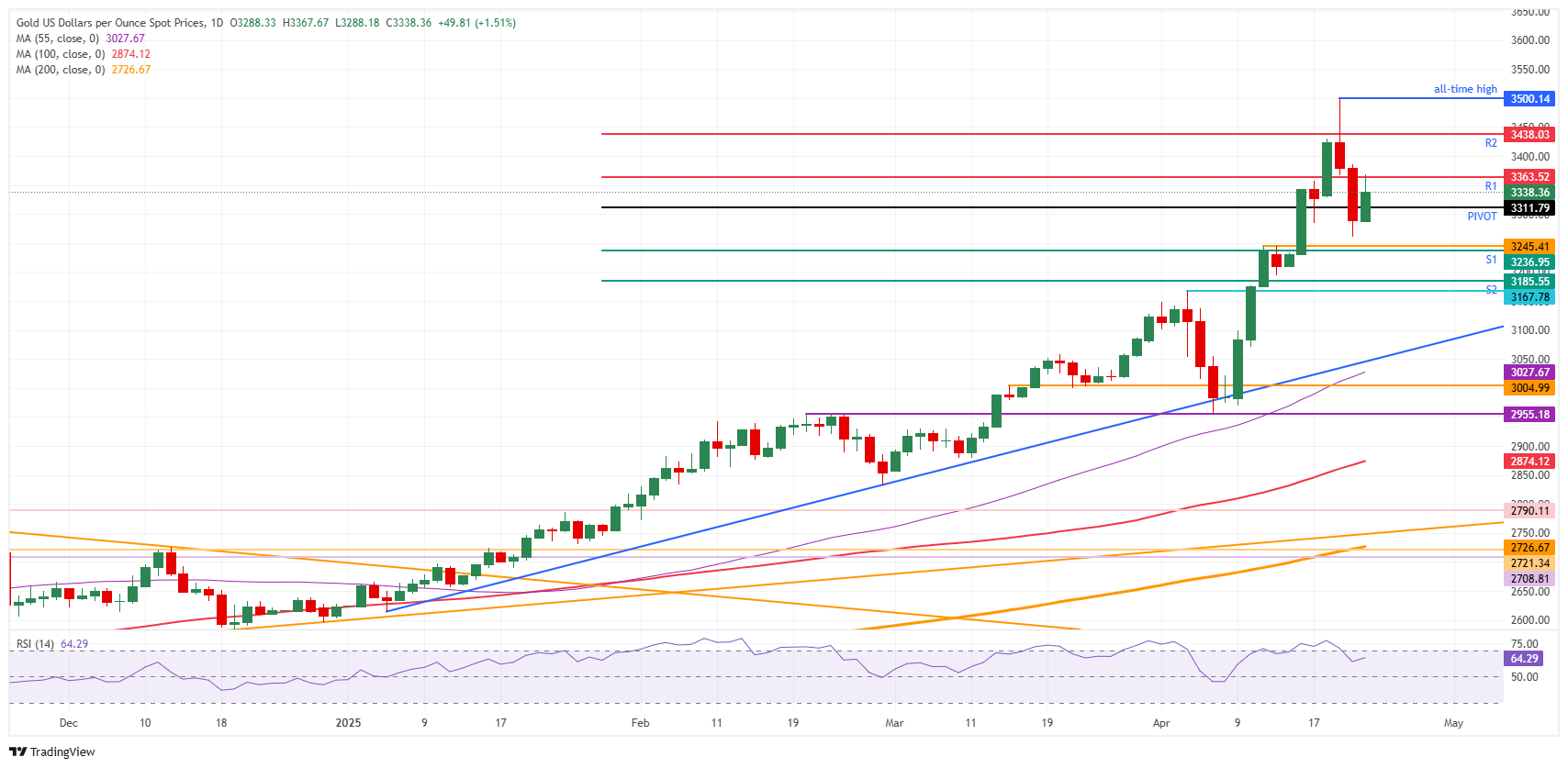Gold price snaps selling off after fresh Trump comments on tariffs
- Gold price edges higher on Thursday after two days of firm selling pressure.
- US President Trump backtracks on earlier statements, China may receive a new tariff rate in the next two to three weeks.
- Markets are back to square one with equities on the back foot and safe-haven Gold being bid.
Gold price (XAU/USD) is turning positive, recovering above the $$3,300 level at the time of writing on Thursday after two days of firm selling pressure since it topped at $3,500 on Tuesday. United States (US) President Donald Trump released more comments from the Oval Office late Wednesday, signaling that China may receive a new tariff rate in the next “two to three weeks” while countries that are currently in the negotiation phase might see reciprocal tariffs come in if negotiations are not going the way Trump wants, Bloomberg reports.
Meanwhile, US Treasury Secretary Scott Bessent said on Wednesday that President Trump’s earlier comments were not an offer to take down US tariffs on China on a unilateral basis. When asked if there was no unilateral offer from the president to de-escalate, Bessent said “not at all”, Bloomberg reports. The Treasury Secretary said that the administration is looking at multiple factors, not just tariffs, but including non-tariff barriers and government subsidies for China.
Daily digest market movers: SNB books gain on Gold rush
- The Swiss National Bank (SNB) has reported that its Gold holdings allowed the central bank to report a profit for the first quarter. The SNB notched up a gain of 6.7 billion Swiss Francs (CHF) from January through March, the central bank said in a statement on Thursday, Bloomberg reports.
- Gold futures in Shanghai followed the recent sell-off in Gold and priced the largest intraday drop since 2013. Chinese investors rushed to take profit on the assumption that a China-US trade deal was imminent after comments from US President Donald Trump on Tuesday and Wednesday.
- Several trading firms are still signaling healthy buying taking place in Gold. “The temporary reprieve from Trump has fizzled out,” said Priyanka Sachdeva, a Singapore-based analyst at Philip Nova Pte. “Investors who missed the dip-buying wagon earlier in April drove the rise today.”, Bloomberg reports.
Gold Price Technical Analysis: Half-baked
Bullion is seeing a slight recovery on Thursday and trades again above $3,300 after a quite harsh correction. Technical traders, though, might not be that rejoicing when looking at the daily price action, with Gold rejected on the topside at $3,367 earlier in the day, which roughly coincides with the daily R1 resistance at $3,363.
Looking at technical levels, the daily Pivot Point at $3,311 has already been recovered in early Asian trading, with the R1 intraday resistance already tested and rejected at $3,363. Further up, Gold price could extend the rally to the R2 resistance at $3,438.
On the downside, a floor is being formed near $3,245 (April 11 high) as an important technical pivotal level, with the S1 support at $3,236 just underneath it. In case that area does not hold, the S2 support at $3,185 and the technical pivotal level at $3,167 (April 3 high) should hold any downside pressure.

XAU/USD: Daily Chart
Gold FAQs
Gold has played a key role in human’s history as it has been widely used as a store of value and medium of exchange. Currently, apart from its shine and usage for jewelry, the precious metal is widely seen as a safe-haven asset, meaning that it is considered a good investment during turbulent times. Gold is also widely seen as a hedge against inflation and against depreciating currencies as it doesn’t rely on any specific issuer or government.
Central banks are the biggest Gold holders. In their aim to support their currencies in turbulent times, central banks tend to diversify their reserves and buy Gold to improve the perceived strength of the economy and the currency. High Gold reserves can be a source of trust for a country’s solvency. Central banks added 1,136 tonnes of Gold worth around $70 billion to their reserves in 2022, according to data from the World Gold Council. This is the highest yearly purchase since records began. Central banks from emerging economies such as China, India and Turkey are quickly increasing their Gold reserves.
Gold has an inverse correlation with the US Dollar and US Treasuries, which are both major reserve and safe-haven assets. When the Dollar depreciates, Gold tends to rise, enabling investors and central banks to diversify their assets in turbulent times. Gold is also inversely correlated with risk assets. A rally in the stock market tends to weaken Gold price, while sell-offs in riskier markets tend to favor the precious metal.
The price can move due to a wide range of factors. Geopolitical instability or fears of a deep recession can quickly make Gold price escalate due to its safe-haven status. As a yield-less asset, Gold tends to rise with lower interest rates, while higher cost of money usually weighs down on the yellow metal. Still, most moves depend on how the US Dollar (USD) behaves as the asset is priced in dollars (XAU/USD). A strong Dollar tends to keep the price of Gold controlled, whereas a weaker Dollar is likely to push Gold prices up.

